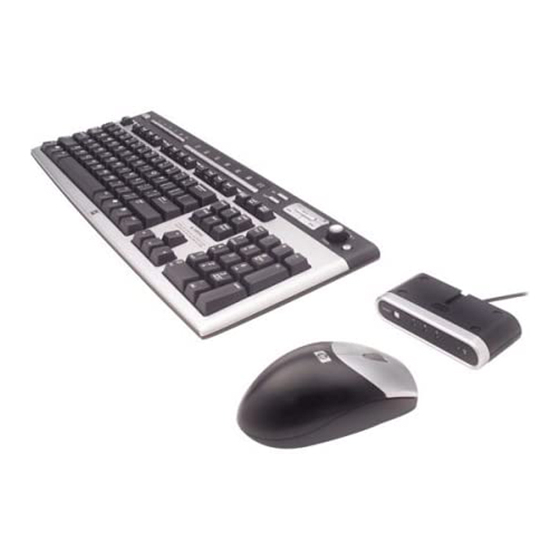Advertisement
HP Wireless USB Keyboard and Mouse
User's Manual
© Copyright 2004 Hewlett-Packard Development Company, L.P.
The information contained herein is subject to change without notice
The only warranties for HP products and services are set forth in the express
warranty statements accompanying such products and services. Nothing
herein should be construed as constituting an additional warranty. HP shall
not be liable for technical or editorial errors or omissions contained herein.
Product Number P2360AA #ABA
Printed in China
Advertisement

Summary of Contents for HP P2360AA #ABA
- Page 1 © Copyright 2004 Hewlett-Packard Development Company, L.P. The information contained herein is subject to change without notice The only warranties for HP products and services are set forth in the express warranty statements accompanying such products and services. Nothing herein should be construed as constituting an additional warranty. HP shall not be liable for technical or editorial errors or omissions contained herein.
-
Page 2: Health Warning
❒ Tightness or stiffness ❒ Weakness or coldness Symptoms may be felt during typing, while using a mouse, or at other times when no work with the hands is being performed, including during the night when these symptoms might awaken you. If you experience these symptoms, or any other persistent or recurring pain or discomfort that you think may be related to using a computer, you should promptly consult a qualified physician and, if available, your company’s health and safety department. -
Page 3: Table Of Contents
Contents Welcome Installation User Setup Identifying Special Keyboard Buttons Special Keyboard Buttons Troubleshooting - 3 -... -
Page 4: Welcome
Welcome Congratulations on the purchase of your new HP Wireless USB Keyboard and Mouse. This guide will provide you the necessary steps to installing and maintaining your keyboard and mouse. Package Contents HP Wireless Keyboard and Mouse 4 AA Batteries... -
Page 5: Installation
Installation Software Installation Insert the CD into your CD-ROM drive. If the setup program does not appear, click Start, then click Run. Type <drive letter>:\setup. Click Ok. (For example, if the disk is in drive D, enter D:\Setup.) Follow the onscreen instructions. You will be asked to reboot your PC. - Page 6 Battery Installation Mouse STEP 1 - Press the battery compartment release located on the bottom of the mouse to open the battery compartment. STEP 2 - Install the two batteries into the compartment paying close attention to proper polarities. STEP 3 - Close the battery compartment cover.
-
Page 7: User Setup
User Setup By default your keyboard and mouse should work immediately. If not, the receiver and the keyboard and mouse must be synchronized and you need to perform the following procedure. STEP 1 - Press the Connect button located on the receiver. - Page 8 Configuration Customize your keyboard settings using “Control Panel” Windows XP – Category View Click on Start, select Settings / Control Panel / Printers and Other Hardware / Keyboard, to customize your keyboard settings. Windows 98SE, Me, 2000 and XP – Classic View Click on Start, select Settings / Control Panel / Keyboard, to customize your keyboard settings.
- Page 9 Configuration continued Customize your keyboard’s special keyboard buttons Once the software is correctly installed, you can customize your keyboard’s special keyboard buttons. To access the configuration screen, click on the system tray. On this screen, you can change the preset actions of your keyboard’s special keyboard buttons.
-
Page 10: Identifying Special Keyboard Buttons
Identifying Special Keyboard Buttons B C D E F G - 10 -... -
Page 11: Special Keyboard Buttons
Special Keyboard Buttons Access and Internet Buttons Figure Key Icon Feature Standby Back Forward Home Search Favorites Refresh Description Puts PC into or out of power-saving mode. Hold key for 5 seconds. May take 10-30 seconds before screen reappears. Returns to the last web page you visited. Views the next web page you viewed before. - Page 12 Special Keyboard Buttons Continued Office Buttons Figure Key Icon Feature F Lock Computer Documents Word Excel Calculator Email Note: For Internet Explorer, change the default program you use for email. Toggles F Lock (See page 13 for more information) Opens the My Computer folder. Opens the My Documents folder.
- Page 13 Special Keyboard Buttons Continued Office Hot Keys This keyboard features 12 integrated Office Hot Keys along the row of the F1 through F12 keys. This feature is toggled by the feature is activated. To turn off the Office Keys feature, press the F1: New Creates a new file in the application you are using (new e-mail for instance).
- Page 14 Special Keyboard Buttons Continued Media Control or Playback Options Figure Key Icon Feature Media controls Volume Control Mute *Note: To change your default media player, open “My Computer”, then click on “Tools” and go to “Folder Options”. In the “Folder Options” screen, click on the “File Types” tab, and then select “MP3”...
- Page 15 Special Keyboard Buttons Continued Figure Key Icon Feature Log Off Previous Eject Opens/Closes the CD-ROM tray. Logs the user out of Windows. Opens your default media player (Windows Media Player or Media iTunes in most cases).* (see page 14) Play / Plays/Pauses the current track/file.
-
Page 16: Troubleshooting
The Universal Serial Bus Controller and USB root hub may not be properly installed on • your system. Contact your computer manufacturer for details. Technical Support For technical assistance call 1-866-314-7239 or visit www.microinv.com/hp Technical Support hours of operation: Monday - Friday 8:30am to 10:00pm E.S.T. - 16 -... - Page 17 FCC STATEMENT This device complies with part 15 of FCC Rules. Operation is subject to the following two conditions: (1) this device may not cause harmful interference, and (2) this device must accept any interference received, including interference that may cause undesired operation. This equipment has been tested and found to comply with the limits for a Class B digital device, pursuant to part 15 of FCC Rules.





